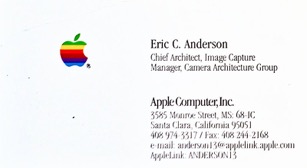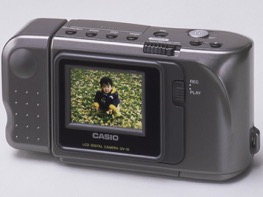A view of Lake Pend Oreille from the mountainside northwest of Sandpoint, and just west of the Airport. My home is just below this viewpoint.
Eric C. Anderson Autobiography 5
Those Glorious Apple Computer Camera Days!
I was merrily working along on getting Cathedral to ship, when I got called into the Director of ATG’s office. He asked me if I had any interest in photography and cameras. I told him I had a deep interest, and had been a photographer since teen years. He then presented to me a quick overview of the Ansel Adam Camera Project, currently being run by a marketing guy, Eric Zarakov, at ATG. Having clearly been successful in getting an ATG technology into products (even though it had not yet shipped - but was very far along) - he felt that what the Ansel Adams project needed was someone who could turn it into a product also. Meanwhile, Apple was working with Kodak to develop the QuickTake 100 camera, shown to the right. No, I had NOTHING TO DO with the QuickTake project. It was entirely completed in Apple’s Imaging Group -a product group.

Apple QuickTake 100
Photo via C-Net
No Pictures (sigh)… and trouble in Product Land
This part of my story has no photos. Why? Because I got pulled into many very big patent disputes, and because of that, all my files were taken by the lawyers. I hope to someday get them back. Anyway, I had agreed to transition to the ATG project during the month of September 1992, but had a major issue come up which ultimately delayed the introduction of the AV Macs for 4-6 months. One of the requirements for ARTA was 100% CPU bus access for very short periods of time, to load and unload the DSP memory of data and/or programs. These bus interruptions typically were in the 1-10 microseconds long, and were spaced fairly far apart, as the DSP spent most of its time processing the data. This idea was anathema to the CPU guys! They would NEVER agree to allow some stupid subsystem to take the bus away for more than a single quad burst! After all, the CPU was king! Of course, they didn’t bother to mention this to me or my boss or their boss. They just violated an essential specification when they designed the custom memory controller for the new AV Macs. Naturally, when the chip was received and tested, everything worked fine… except the DSP. Being totally starved for data and program code, it basically did nothing. Big surprise, there. So, they called me in to explain why my stuff was not working. It did not take very long to find out what they had done. They got some hands slapped and had to rework the design and resubmit the ASIC to be remarked. When it returned, it worked perfectly. They still did not believe it, and thought it was a very dangerous precedent. Seeing, apparently, is NOT believing. At least in some cases. Anyway, once that little bonfire was fixed, back to ATG I went…
The Ansel Adam Project: Apple WAY AHEAD OF ITS TIME!
We just called it Adam. There was actually quite a bit of work that Eric Z. had accomplished. Being a marketing guy, he did a lot of market research and studies on use cases. And, his team - now my team - had put together quite a wonderful prototype. It was a hand-held camera with full video capability, as well as still capture. It also recorded audio clips. You could edit on the camera, you could do slide shows, you could annotate, and record audio and sync a series of images. It had many of the features you now take for granted in a digital camera. THIS WAS IN 1992! Now, to be clear, it had some cables coming out of the handheld unit, that ran under the table to a Mac, with a video capture card. All of the software was on the Mac. The camera buttons were mapped into keyboard buttons. But it was a killer demo. My job? Cram a Mac into the hand-held unit so it could be shipped as a product!
The team had tried to work with Kodak - after all, Kodak and Apple were working together on the QuickTake. However, from what I was told, the team had many blow-outs with Kodak - even screaming sessions. At one point, when they had brought the demo to Kodak to show, a group of lawyers had come into the room and told the Apple team members "We own that technology." At that point, at least one Apple engineer left and returned to Cupertino. When I joined the project, the team was working with Sanyo as the manufacturer.
I spent a year and a half developing the concepts and underlying architecture and technology. In those days, it was VGA or slightly higher resolution - that was all you could get or afford. We developed what we called ACA: Apple Camera Architecture. This new approach used a small but powerful CPU running at 100 MHz, a block of DRAM (digital cameras all used SRAM at the time, much more expensive, and much less memory), and the single CPU did everything: took photos, processed them in the background, did the GUI (graphics User Interface), managed the file system, the whole works. It required a multi-tasking OS, since multi-threaded processing was required.
Kodak or Sanyo?
When the project was moved to Product Engineering in 1994, we were told by a back channel that we could choose either Kodak or Sanyo, but if we choose Sanyo, the project would be cancelled. Having not yet been trained in leadership, I caved. It was a disaster at Sanyo, and Kodak hated our guts. It took a lot of effort to smooth the waters on the Kodak side. In fact, when we went to Kodak Japan to present ACA, they were horrified! The NERVE of Apple to tell US, KODAK, how to build a camera! They had an engineer rush out of the room and throw together a 3-page document to show all of the camera architectures that Kodak could think of (but never used). Naturally, that document was dated YEARS after ours…
I believe that decision was a major mistake: we could have shipped a working camera with Sanyo by 1995 at the latest. Well, we got the Kodak mess to deal with, and then the Imaging Group manager - an ex-Kodak guy - declared that we had to go after the "underbelly of the market" (low price) and NOT after the more expensive Adam concept camera because of the "expensive" 2 inch color LCD. That would boost the price at least $150… So, we left Adam as a later high-end camera, and worked on Aspen and Phobos, cameras with only status LCD’s like the QuickTake. Naturally, being a good engineer, we selected a CPU with the appropriate memory bandwidth and processing power when no video display was required and no GUI.



My Apple Business Card while working on the Aspen and Phobos Camera Projects
Working With Kodak
We managed to get along. Like our buddies in the CPU Engineering Group, however, there were major problems when they did not listen to us and went their own way. It cost the project at least a year. We asked them if they knew how to write multi-tasking, multi-threaded software. They insisted that they did, and the spec called for the camera software capture subsystem - called from our software, and that they were responsible for writing - was running on as a software task. When we got their software dump, it failed totally, because they, like all camera software developers at the time, assumed that once the shutter button was pressed, they had 100% of the CPU and resources to do whatever they needed to do. Naturally, they immediately disabled interrupts and proceeded to do just that. The multi-tasking OS died a horrible death without the clocks and timers that kept it alive.
So, we had to send engineers from our team to Japan for a few weeks to teach them how to write multi-tasking software. One year delay. They hated being told what the API was for their subsystem. They hated being told how the ASIC had to work. They hated being shown a better way to compress 10-bit data from the A/D convertor to 8-bit data. They hated having us define the Power Manager. In general, they hated us building the camera of the future. Can you believe it? We even had to teach them how do to auto-focus in software…!
That Fateful Day…
The Phobos/Aspen projects were moving along - originally scheduled for shipping in 1995, moved to 1996 due to Kodak issues, when Casio introduced the QV-10 - the first digital camera with a LCD screen. This was quite a blow to our team - we were in the "we told you so" mood, and Kodak and Apple management were in a uproar. Kodak insisted we "slap" on an LCD to the cameras so we could compete with Casio, who was claiming 90,000 units per month! But remember, we downgraded the CPU and memory to save money for the "underbelly of the market" and thus, could not practically just "slap on" an LCD. So Kodak cancelled the project, forcing Apple to do likewise (there was a lot of fighting between the two managements over that decision).
The QV-10 was no Adam. It was a single timeline software, so when you pressed the shutter, there was a ½ second delay, then for maybe 3-5 seconds, all buttons did nothing, as the camera processed the image. But, it was still a marvel. It also did not have API’s and was not an OS, so it could not run applications, and had no scripting language, which our OS, called FlashPoint/OS at the time, did.
What Was Lost
Sanyo had told us: we would be the FIRST to ship an LCD-based camera. That was based on working with them, of course, and they knew about the Casio project. Too bad we switched to Kodak. Apple would probably be a leader in digital cameras today…

The Casio QV-10, introduced in 1995

1996: A Year of Transition
We were a project without a product. So, while management was focused on bigger issues, like losing money, and losing sales in the Mac division, we decided to start working on Adam. We developed the architecture around a chip from Motorola, the 823, which we helped them developed to meet our specs. We started out with the 821, which did not meet all of our specs, but we could at least start coding and building some hardware. We dropped the 401 PowerPC chip as too week and anemic, and also dropped OS/Open, and switched to VxWorks. We developed working boards that could be used to develop full cameras by plugging in a camera head plug-in board. The board had our improved Power Manager, the main processor with built-in DSP, 8 Megabytes of DRAM, the LCD and other functions, such as buttons, flash disk, etc. We were working on building the underlying OS building blocks, such as the graphics engine and power management. We were also filing patents like crazy. Our system could take photos immediately, one after another, no significant delay, because they were processed in the background by a spooling mechanism that we patented. There were many features we included that did not reappear until the iPhone was introduced in 2007.
The management of Apple wanted to save all of the work we had done, but were in a financial bind. So, they found a buyer, and we were spun out of Apple as a start-up named after the OS, FlashPoint Technology, Inc. We stayed inside Apple for several months until a building was made ready, and moved out in November, 1996. It was an exciting, and sad day.
Previous Page
Next Page
Copyright © 2017 Anderson Creations. All Rights Reserved.


